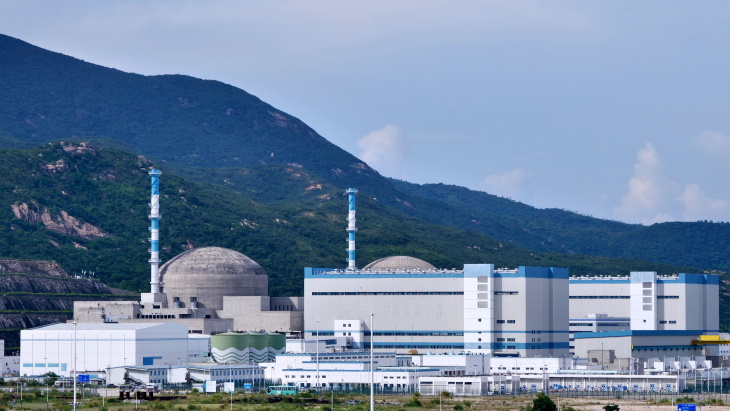Chinese EPR resumes power supply after extended outage
Unit 1 of the Taishan nuclear power plant in China's Guangdong province offline has been reconnected to the electricity grid after having been offline for more than a year following the discovery of damaged fuel rods.

Taishan units 1 and 2 (Image: TPNJVC)
The 1750-megawatt EPR entered commercial operation in December 2018. However, in June 2021 - midway through its second fuel cycle - an increase in the concentration of noble gases in the primary circuit of Taishan 1 was attributed to a few damaged fuel rods. China's National Nuclear Safety Administration (NNSA) estimated that of the more than 60,000 fuel rods in the core of Taishan 1, about five probably had damage to their cladding. The core of Taishan 1 contains 241 fuel assemblies, each of them made from 265 fuel rods.
China General Nuclear (CGN) took the unit offline on 30 July last year to investigate the cause of the fuel damage and to replace the defective fuel rods.
Following an inspection of Taishan 1 between 26 and 29 July, the NNSA gave its approval for the reactor to be restarted.
In a 16 August filing to the Hong Kong Stock Exchange, CGN said: "The work for the inspection and maintenance of Taishan unit 1 has been completed and Taishan unit 1 will be connected to the grid for power generation on 15 August."
Details about the cause and extent of the fuel damage were not disclosed.
Taishan 1 and 2 were the first two reactors based on the EPR design to begin operating. The reactors entered commercial operation in December 2018 and September 2019, respectively. The Taishan project - 140 kilometres west of Hong Kong - is owned by TNPJVC, a joint venture between CGN (51%), EDF (30%) and the Chinese utility Guangdong Energy Group (19%).
In Europe, the Olkiluoto 3 EPR in Finland was connected to the grid on 12 March this year and is scheduled to enter regular electricity generation in December. EPRs are currently under construction in France and the UK: Flamanville 3, currently expected to start up in 2023 with commercial operation in 2024; and two units at Hinkley Point C, currently slated for commercial operation in 2026 (unit 1) and 2027 (unit 2).
Researched and written by World Nuclear News
- China Institute of Atomic Energy
- Nuclear Power Institute of China
- Southwestern Institute of Physics
- China Nuclear Power Operation Technology Corporation, Ltd.
- China Nuclear Power Engineering Co., Ltd.
- China Institute for Radiation Protection
- Beijing Research Institute of Uranium Geology (BRIUG)
- China Institute of Nuclear Industry Strategy (CINIS)
- China Nuclear Mining Science and Technology Corporation


